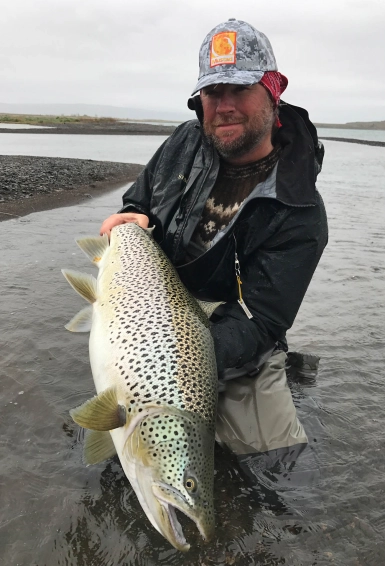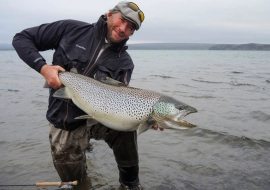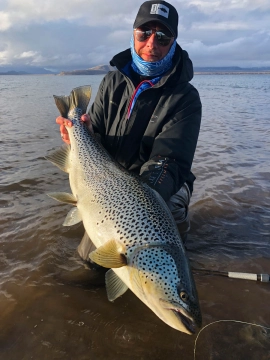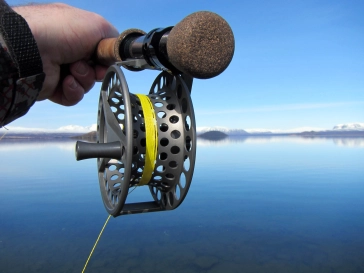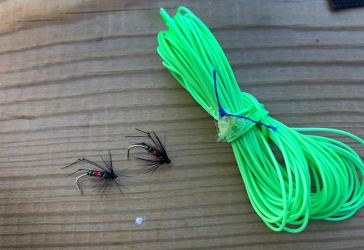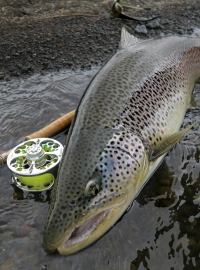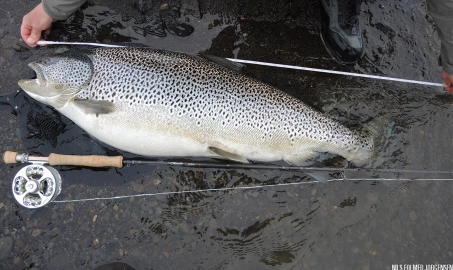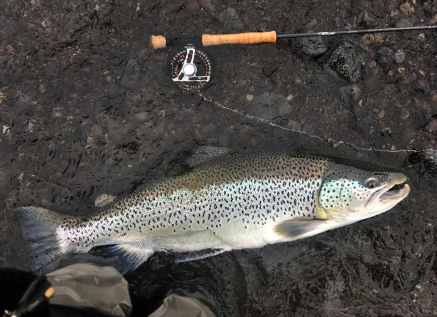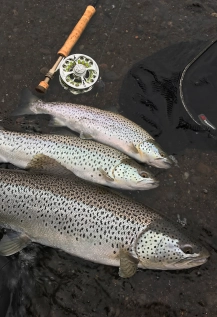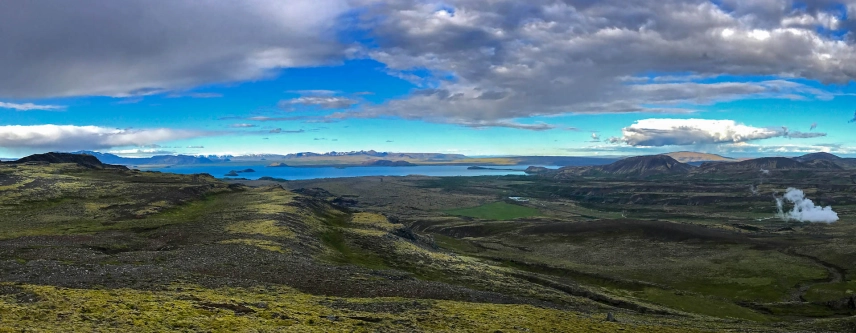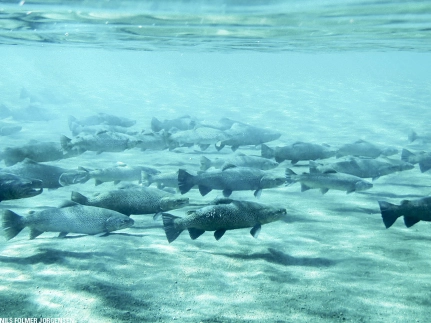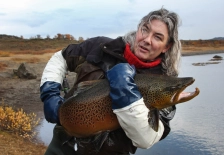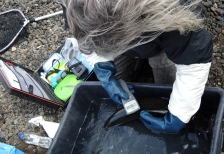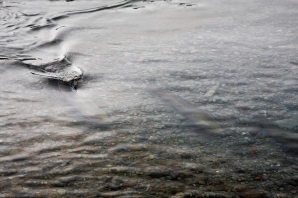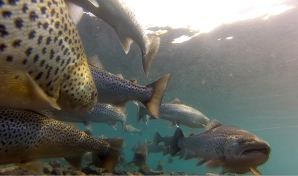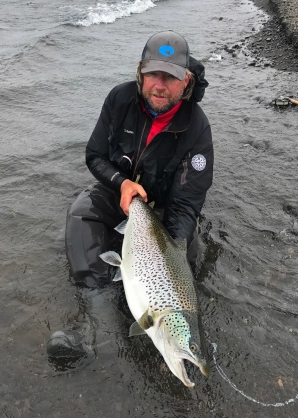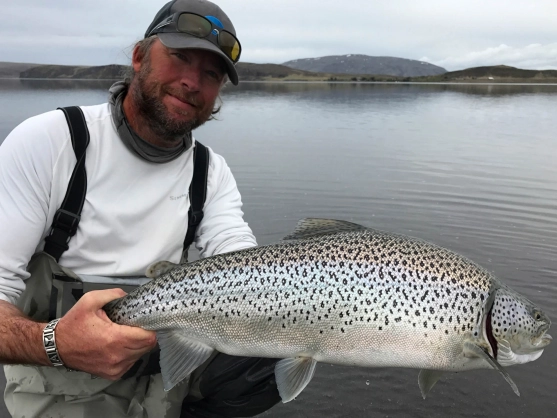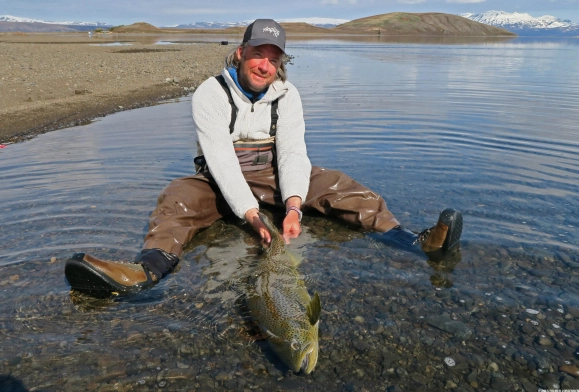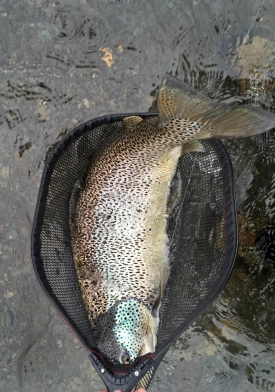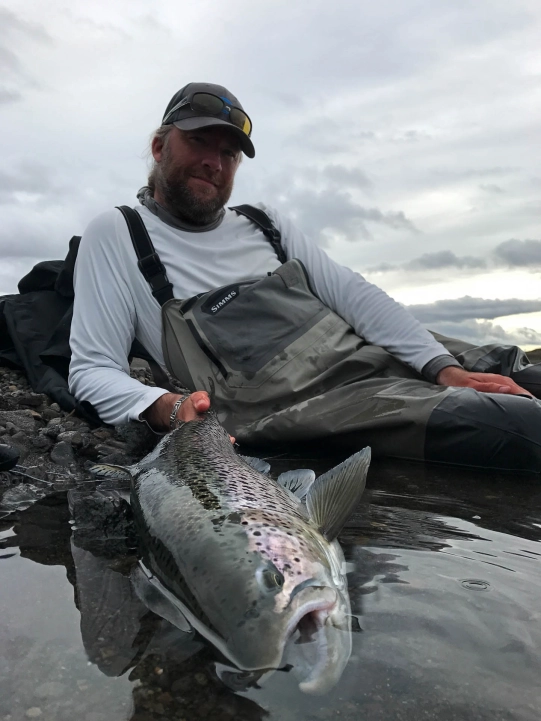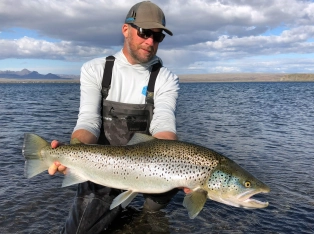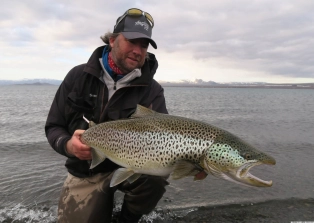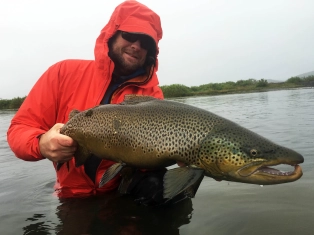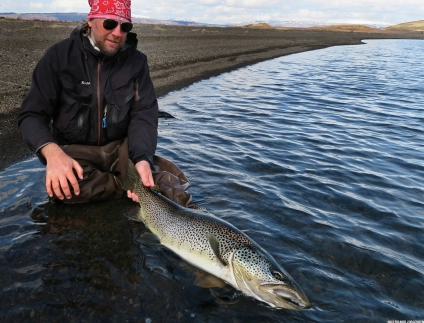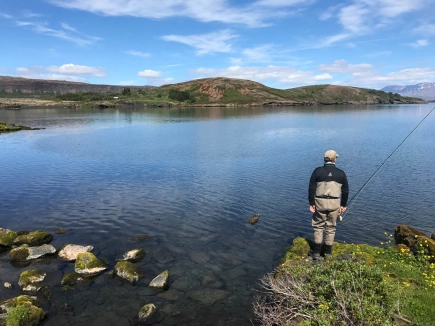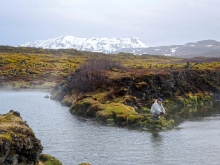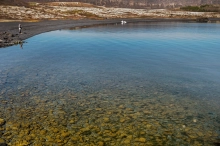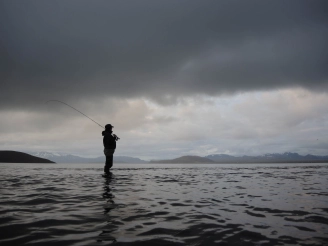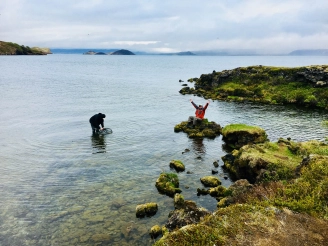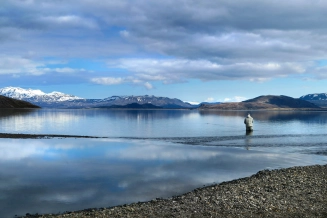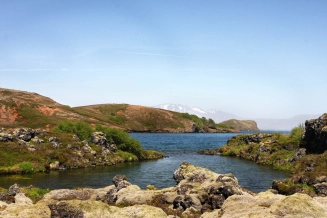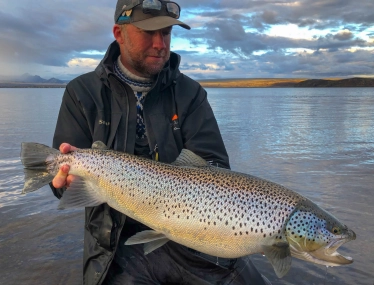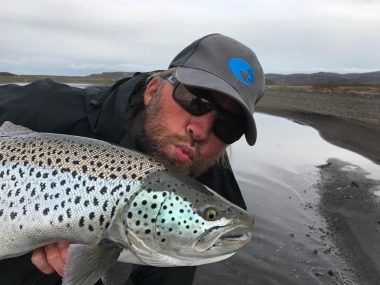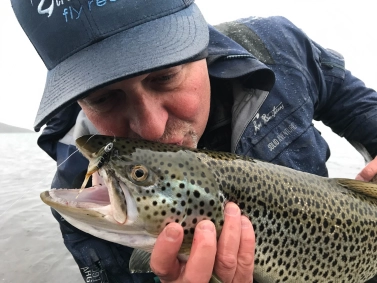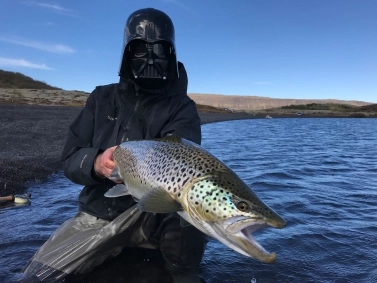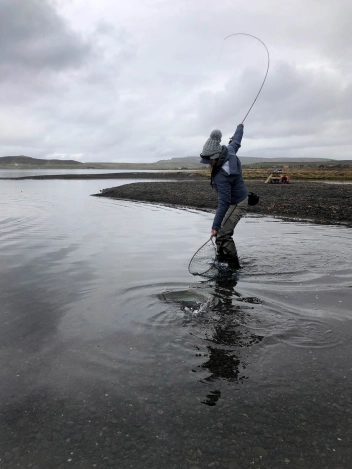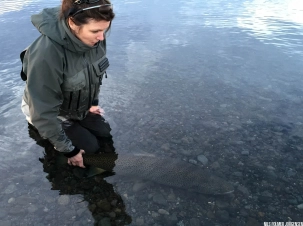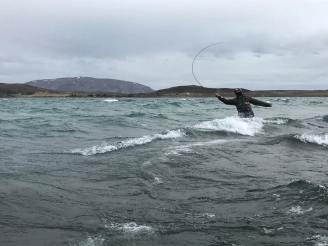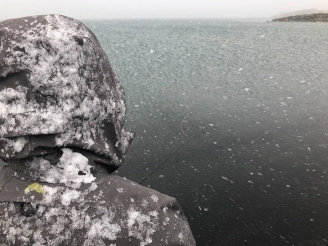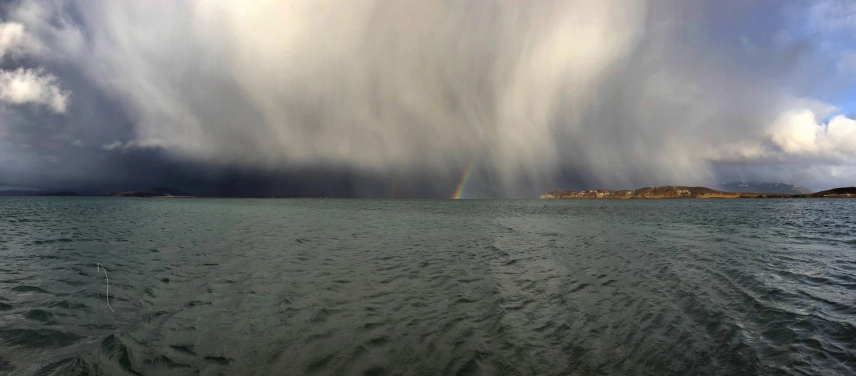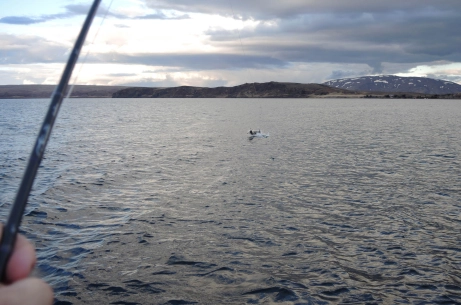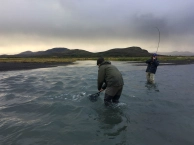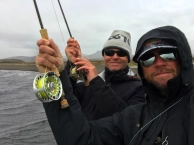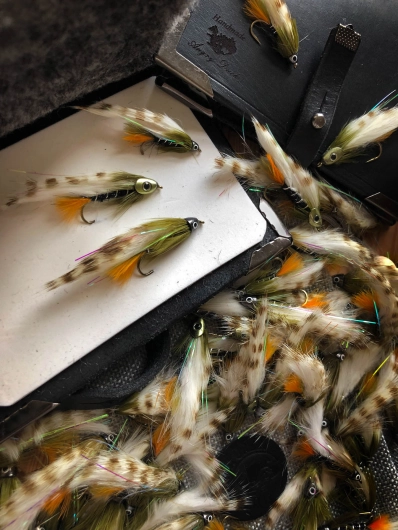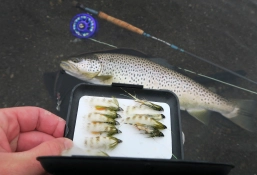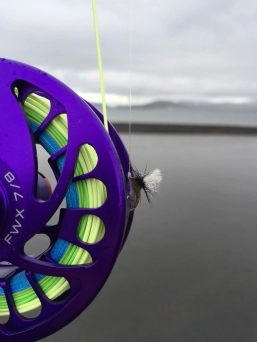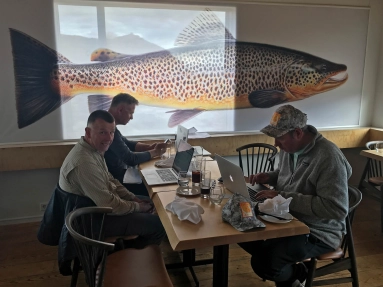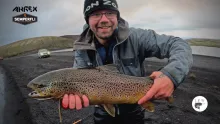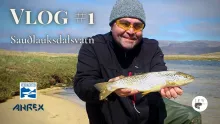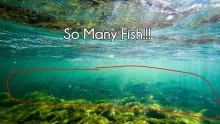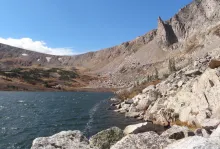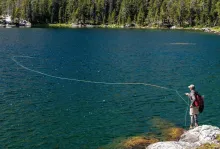The Icelandic lake Thingvallavatn has become synonymous with monster ice age brown trout. People from all over the world come to chase their dream fish. Many have their dream come true from the first cast, others go home empty handed.
Here you have 16 years of hard earned experience from a non-tourist angler on what to expect and where to start on Thingvallavatn, Iceland.
The stories
The stories of anglers getting spooled by the monster trout in Thingvallavatn (AKA Þingvallavatn or Lake Thingvellir) had also passed my nose.
The land of Sagas.
The legendary stories of the monster in the local pond eating the ducks and dogs.
Grandfather hooked it, but the beast won.
Well, I did not believe all of it, but the part on getting spooled by monsters turned out to be true.
My first experience
My first experience with a close encounter was when flexing my 6 weight rod into a nymph-hooked fish. I had just set-up a new reel with 140 meters of backing, 30 meters of fly line and a 4 meter leader, so more than 170 meters or 550' to give. I did not see the fish being hooked but only the line disappearing in a nonstop steady pace, until there was only a few meters of yellow backing left. I believed it was a foul-hooked fish and did not want to loose my line so just put my hand on the spool and blocked the fish. The leader and size 12 fly endured the pressure, and I could start dragging in this heavy fish that was about 170 meters out. To my surprise, the hook was right in the upper jaw. I had just been treated to the power of a mint condition Thingvallavatn brown trout weighing 9.5 kilos or some 19 lbs.
Next week, I got spooled!
Next week, I got spooled! A fish took all the line and broke off on the backing knot on the reel. That is over 170 meters or 550' for a fresh water fish! Several other fish came close and I had to break a few off, so time to change my setup. Since these experiences, I have used a bonefish reel with 250 meters or more than 800' of backing!
So, the stories were true.
I do however believe that many of the fish that “disappear” are foul hooked. I can for sure feel it and can also see on other anglers' rod actions. I'm usually right after seeing how the rod works and the fish behaves. Note that the only place foul hooking can be a problem is on the ION beats where there is an enormous concentration of fish.
Not all the fish have this temper. Most fish will do 30-70 meter runs (100-200'), but that is still more than any fresh water species that I have fished for.
How it started for me
I am by far mostly into fishing in rivers when it comes to trout. Many years ago now, my friend Gummi took me to some of his fishing areas on lake Thingvallavatn. This made me step out of the river only zone.
Sight fishing big brown trout with delicate tackle using dry flies and nymphs was just amazing!
It was a different kind of fishing than on the rivers, different behavior from the trout, but when we cracked the code, this was heaven on earth. The massive and strong fish just exploded when hooked and took off like a train.
Every fish in the hand was a jaw dropping experience, and still is. I had never seen such massive condition in trout before, along with the most stunning colorization and scale patterns. Not to mention the size of the fish! Most of them were between 2.5 and 6 kilos – that's 5.5 to 13 lbs! A 2.5 kilos brown trout is a personal record for most people coming to Iceland. Note that these are truly wild fish which are not feeding off hatchery waste.
It did not take long before I got addicted and knew where to spend my time in the spring.
Nils Folmer Jørgensen
Unique
Lake Thingvallavatn is located on the ridge dividing the North American and Eurasian tectonic plates, which are moving away from each other with about 1 cm or about half an inch per year.
With a surface of 84 square kilometers or 32 square miles, Lake Thingvallavatn is the largest natural lake in Iceland. The greatest depth is 114 meters or 375' and the lake has an average depth of 34 meters or about 100'.
The lake is very fertile and rich in vegetation, despite the low temperatures. 150 types of plants have been discovered in the lake, which is also popular among divers due to the gin clear water and stunning waterscape.
Some numbers
The water temperature is mostly around 2-6 degrees C or 36-43 degrees F, but several hot springs attract fish and speed up their metabolism. This is one of the reasons why the trout grow to the enormous sizes. Clean open water for hunting and warm hot springs for digesting.
In fact local biologist Jóhannes Sturlaugsson, who has been doing research on the lake for 21 years, can conclude that these fish can grow with 10 cm or 4” per year!
The brown trout's main food source is the Arctic char called Murta (Salvelinus murta, a small, endemic char). I have caught endless trout coughing up Murta of around 25 cm in length. Even small trout just weighing 2,5 kg or 5 lbs.
Through efforts such as catch and release, we have seen the stocks increase dramatically. We have tagged over 500 trout through the years, and therefore have been able to collect lots of data. Not to mention terminating the accusations that the fish die after a catch and release!
Johannes Sturlaugsson has monitored the brown trout in Lake Thingvallavatn annually for roughly 20 years. During that period the brown trout stock has expanded enormously. According to Johannes the total number of spawning fish in the rivers last autumn was around 3,000, compared to 1999 where the number of spawners was more like 100 (www.laxfiskar.is).
On the top of that number, you will find mature fish taking a break from spawning. They were estimated to be around 1,000.
In addition to the spawners there are all the thousands of immature brown trout, also influencing the angling in Lake Thingvallavatn. Due to late maturity, the immature brown trout in the lake can be very large, often up to 6 kilos or 12 lbs. or even more.
Along with the increasing number of fish, you also have the increasing number of larger fish and older fish, this caused by the longevity of the brown trout. In the autumn 2019 Johannes captured many old timers in the river Öxará in his research fishing, the oldest one being 19 years old, which is the highest known age of brown trout in Thingvallavatn. The oldest fish had participated in spawning up to 8 years.
But as the brown trout in Lake Thingvallavatn sometimes take a break from spawning, some of the fish had been entering the spawning grounds through a 12 year period. In this context it is interesting to mention that during his monitoring Johannes has managed to recapture the same individual brown trout 8 years in a row, when the fish entered the spawning grounds of the river.
Sizes and what to expect
This is where it becomes interesting for many of you guys.
Yes, we probably have the world's biggest wild brown trout – and in numbers that are second to none. Most anglers I bring have a personal record on their first catch here. I have seen quite a few dreamers go home with the sweet smile of victory on their face.
By far most of the fish are in the 60 to 75 cm range (24-30”). Then there are good numbers of fish from 75-85 cm (30-33”), and then there are the really big ones from 85-92 cm (33-36”). It is worth mentioning that the girth of these fish is not comparable to any wild trout I have seen. The fish are incredibly massive.
The really big fish
From time to time it happens that we see some fish that stand out, and can be called really big fish. I know of three witnessed and documented fish that are over 100 cm (40”).
I am one of the lucky anglers with a 101 cm beast with a 64 cm in girth on my resume! Yes, that's 40 inches long and 25 inches around the belly! This is more like a hog than a fish and does not look like the average trout in the lake. Biologist Johannes Sturlaugsson suggests that the brutal girth could be caused by the fish having never spawned.
According to the average online fish calculator, this fish could weigh 18,6 kilos making it a 40 pound fish. I am absolutely fine with it just being over 30 pounds. A 30 lbs wild brown trout...
But it shows that there are some surprises hiding in the deep, which we do not necessarily see in the river where the fish spawn.
A far majority of the fish caught in the lake, are from the ION beats. I would assume around 80% of the fish are landed on the four rods fishing here. The two beats produce around 2,500 trout each season. The three documented 100 cm fish all come from the ION fishery. I think there was a post-spawn 100 cm fish caught in Kárastaðir also, but I can't confirm this.
After fishing here for 16 years and landed over 1,300 trout, the above mentioned sizes is what you should expect.
Don't go there expecting a 20 pounder, and if you catch one, let the champagne flow.
But a 14 pounder should be celebrated just as well. With 2,500 trout landed on a ION during a season, I can get a realistic picture of how many fish over 15 or 20 pounds there are.
I have also placed underwater cameras on beat II on ION, and observed fish sometimes packing in schools of 100-200 fish. There are not as many over the 20 pound mark as some would like to believe, but they are still there in good numbers for sure!
I'm not writing this to be pessimistic, but more to be realistic, and give anglers who have been sold the whole package a realistic view of what to expect.
A golden spoon
I'm born with a gold spoon up my butt, and out of my approximately 1,300 trout, maybe 15 are over 20 pounds. When that is said, on a good day on ION, I don't even bother the measure a fish of 65-75 cm anymore (that's sub 30 inches).
I once experienced landing four fish between 80 and 86 cm in a row (31-34 inches). I don't even know have many I have caught between 78 and 92 cm (30 and 36 inches). Who cares?
This kind of fishing is out of this world and every fish is running on Ultra Plus Extra Duracells and shines with perfection. Of course we have some out-spawned, damaged fish each spring but they turn out to be very important for the lake, having spawned up to eight times in their lives.
Where
With a surface of 84 square kilometers, there is lots of water for a little fly to find a fish. There are many areas where there are no brown trout, and as already mentioned, some areas where they are shoulder by shoulder. The ION fishery is by far the best for over 2,500 trout caught per season on only four rods. The fishing there can simply be crazy! I don't know of anywhere else in the world where there is such a big concentration of huge wild browns.
It is not only the number of fish that makes it fun to fish, but also the techniques used. Small dry flies, nymphs and delicate tackle is by far the best technique in prime time.
When the weather is calm, a streamer angler with a sinking line can mess up the whole area in no time. But when the weather is rough and producing high waves, the streamer is the solution – and a very effective one. In fact the rough weather makes the fish much easier to catch. It's just a question of finding them. On calm days where the delicate fishing is on, it can be a struggle to get just one bite, even though you have a hundred trout around your fly. As you know, that's how trout can be.
The two ION beats
ION is divided up in two beats. What makes them both unique is warm water springs. Beat I has four underwater hot springs while Beat II has a river entering with slightly warmer water than the lake.
It is clear that the big brown trout come in schools, and move in and out of these areas to speed up their digestion.
You can see them come in and just park like cars, just sitting there, like we do parked on a couch after eating a big steak. Otherwise you will see big schools cruising around in the upper water layer sometimes with their back breaking the surface. Cold water is heavier than warm which explains this behavior, at least in theory.
Big trout are normally territorial but here it's completely different. It is not rare to see 100-200 big brown trout cruising around like tarpon. I have a theory that these fish go out to the deeper and colder water to hunt like tuna and some whales. They pursue their prey, and push it up towards the surface before having a feast.
I think it would be difficult for a big fat trout to catch a small speedy fish in a fish-to-fish pursuit. But teamwork in the mid-water it is a different story. Note that this is just my theory, which I put together after seeing splashing out on the middle of the lake over very deep water.
It's a fact that the Murta live in the colder water and the trout go there to catch them. Then they come into the ION beats to digest. As I mentioned earlier, many of the fish I have caught have half digested Murta coming out from their throat.
Greedy fish
What is amazing is that they are still taking our small flies, even when having a fish sticking out of their throat!
Once I was fishing with some of my friends from Scotland and the US. We had around a hundred big trout right in front of us on beat II. The fish were very difficult to catch. I landed one which coughed up a Murta of around 25 cm or 10” long. To show the guys the greed of our beautiful spotty friends, swimming in front of us, I tied the Murta onto my leader without a hook, and just swung it slowly out to the nearest trout. Within seconds, at least five big brown trout were fighting over the Murta in a scenery reminding of crocodiles rolling their prey. They did not let go even though there was no hook and a good flex on the rod. Eventually, they won the snag. Again this explains why the condition of these fish is so outstanding.
Other beats
Anyways, ION should not be confused with other beats on the lake. I have met people who I think have been effected by the success of ION and think that this is how it is in other locations on the lake. Well, it is not! Some have fished a week without a pull other than from Arctic char.
ION is by far the best fishery on the lake with around 80% of the fish caught there. It is also the most expensive fishing in the lake, no surprise...
Nils Folmer Jørgensen
I have been fortunate to have fished a lot on ION and it is also where I spend most of my time today. But I have through the years tried many other places around the big lake where there are some very interesting spots. Kárastaðir and The Black Cliffs are a couple of them. I fished there a lot before it was taken over by an outfitter, who is now doing a good job with limiting the rods and making it C&R. And the prices are fair.
Especially The Black Cliffs caught me, and is my second favorite after ION. It is more regular wading with long casts and a streamer at the end of the line. It is quite simple, when you have found the fish, they just hammer the fly. Sometimes I have landed 10-12 fish in an afternoon. So it can be really good. But it all depends on the wind here!
Daytime fishing
It was said in the old days that the fish only came into the shallows in the evening and night. Not true! I caught almost all my fish in the daytime when people were home preparing for their evening fishing.
The fishing techniques are different from ION. You are fishing for trout on the hunt and not big and lazy digesting fish. You won't be needing long thin leaders and small flies. On ION we always use floating lines, but on The Black Cliffs a sink tip can come in handy in high waves. On the location Kárastaðir, it is really deep and sinking lines are used by some anglers.
There is also the Villingavatn beat close to ION. I also fished that quite a lot in the old days, and sometimes had excellent fishing with the techniques similar to those used on ION. The Villingavatn beat is now run by the same outfitter who is handling Kárastaðir and The Black Cliffs.
Veidikortid.is has a big part of the northern bank of the lake, with the largest area available on one license, and also the least expensive. In fact you can buy a yearly fishing permit, which covers this and 33 more fishing locations in Iceland. The area is very beautiful with many bays and small islands. I have not fished much here so can't really tell you how to crack it.
I know from fellow anglers that the techniques are similar to Kárastaðir and The Black Cliffs, but you often need to work a lot for each caught trout. I would definitely hire a guide the first day if visiting here. Make sure to get someone who actually has fished and caught a lot there!
Nils Folmer Jørgensen
New land, new water
There are still areas around the lake where you can get a fishing permission from the land owners very cheaply. Some do find new areas. The few anglers I know who pioneer new fishing grounds hold their cards extremely close to their body for good reasons.
I know three locations that I would like to visit after hearing some stories from the land owners about big trout swimming in their gardens. My time is limited right now, but one day I will go explore new grounds.
I have of course been brought some of my fishing on a silver platter by friends with the same addiction is me. I should be more grateful… Thank you guys!
There are many areas out there that has never been fished and probably never will. I have done my share of research, but have settled with spending April, May and early June on ION and The Black Cliffs before the salmon arrive. On a good season, that can mean 150 trout in the hand and that is really more than enough. My personal best catch is 24 brown trout in one evening.
Season
The season is slightly different from location to location. Generally, the lake opens just past mid-April and closes mid-September. The weather can be a nightmare in April and May. Come June, summer is there. July and August is true summer, while the weather in September can start shaking things up again.
Fishing is really good on ION Beat I in the hot springs when the season opens no matter the weather. There are fish there all winter. The whole lake might be frozen over, but is ice free in the east side of the bay on Beat I. 25 degrees hot spring water keeps this part of the lake ice free.
Early in the season the fish are often easier to catch, but in the prime time they become tricky. The number of fish will increase, and they will often be visible in the surface. Dry fly time! Beat I peaks in May till mid June.
Beat II on ION can be good in April but is far more stable in May and actually until the season closes in mid-September. Prime time is also mid May and all June. You will see lots of fish all summer but they are very challenging, even for a skilled angler. In September some of the fish have changed into spawning colors, shape and behavior. You will see them jump more straight out of the water like salmon, and they are like a totally different fish. Not many anglers are fishing at this time. There are normally quite a few open rods on ION during July, August and September, which is a good option to get started there. Not to mention that it is also cheaper. There is always fish on Beat II at this time!
Kárastaðir, The Black Cliffs and veidikortid.is are located close to the river where most of the trout are spawning. It is therefore natural that many of the out-spawned trout are searching for food in these areas in April. But we also catch the big fat ones at this time. The safest and best time is in mid May til beginning of June.
The Villingavatn River Beat is great in mid May and June like beat II on ION.
Tackle
I'm not going to spend any time telling you that you have to use and certain brand to catch a fish. It really does not matter. I will instead give my opinion on what to use and why. You can catch a fish on all kinds of gear but like in any sport, you can optimize you tools and techniques.
On ION, I more or less only use #6 rods mounted with WF6 floating lines. I have two rods rigged up:
- A medium/fast action rod for the dries and nymphs.
- A fast action for when the winds bites and a weighted steamer might go at the end of the line.
I would not recommend heavier line weights or stiff rods for the dries and nymphs. The fish simply straighten or pull the hook. Also the leaders snaps in the take. I could tell endless stories about this both from myself and from people I have taken there. They lost almost all fish until changing to a softer rod. The solution is not a thicker leader and bigger fly, because then you simply won't get the takes.
Rough weather
A few times when conditions have been heavy northern winds right in the face, I have taken out a fast action #7 and a short belly line in order to punch just 10 meters of line out. I caught a lot of fish in these conditions right in front of my feet. The fish become very easy to catch in rough waves.
I remember my friend Kasper and I standing shoulder by shoulder one morning. I had actually given up getting the fly out but Kasper kept going and managed to catch one right at his feet. I used what was left of my good fishing spirit to go out next to Kasper and give it a final go. A huge fish swam right in front of Kasper under his rod tip but did not take his fly. I served it my Olive Ghost fly and the guy with the golden spoon had another hookup! If I remember correctly it was a 93 cm (36+ inches) massive fish, probably weighing over 10 kilos (22 lbs). This is how easy it can be.
For the dries and nymphs, I use a 12 foot tapered leader which I extend with tippet to one and a half rod length. The tippet is mostly 0.20 mm (3X or 0.008”). Both leader and tippet is Fluorocarbon.
Don't put out any fly line that sinks when the fish are swimming just below the surface. A fly line going down between the fish spooks them off. I can again tell endless stories about how fish react to this.
For the streamers in rough water, the presentation isn't critical. Use the same setup, but increase the tippet to 0.28-0.30 mm (0X or 0.011”). You can also use a more aggressive taper on the leader.
Use the same setup on the Villingavatn River Beat.
In the rest of the lake, use the #6 fast action set-up. Sometimes #7. An intermediate line has come in handy a few times for me, and I know of anglers being successful with sinking lines on Kárastaðis, veidikortid.is and places on the east bank. Personally I don't enjoy the sinking line fishing, so I stick to the places where surface fishing is the name of the game. Just like salmon or most saltwater fishing I do, visual and delicate fishing just gets me going.
And remember: 250 meters of 25 pound backing!
And remember: 250 meters of 25 pound backing!
Flies
The dries and nymphs should be in dark shades of olive, brown, gray and black. All kinds of patterns work, but a Black Gnat dry and Pheasant Tail unweighted in size 12-16 is a safe bet. Sometimes and in some places, weighted nymphs are needed. From mid June there has been days with hundreds of trout slowly cruising around showing no interest in any fly in my box. Then I have successfully provoked their curiosity with big indicator loch style flies from the UK and even monster ant imitations in orange!
Otherwise there is no way around my own streamer pattern which I call Olive Ghost. I made this fly in 2008 after seeing sticklebacks in the shallows. So I made a fly to imitate these small fish. It has reminiscences of the classic Black Ghost but this is a UV dubbed zonker with an orange tail and an olive hackle. By far most the streamer-caught fish in ION are caught on this fly. It really is amazing how they just eat this thing sometimes when everything else is out.
Make some with a light head and some with tungsten. I paint eyes on the cone or use Jungle cock. An olive Fish Skull also looks great but I personally don't like the way it makes the fly move in the water. We will return with an article on this fly.
And never go anywhere without a black Woolly Bugger!
Movie
If you want to have a movie version of a season on the lake, check out this video Monster Brown Trout in Iceland.
Contact
Find the ION Hotel here. You can also buy fishing licenses at the hotel.
Johannes Sturlaugsson's research is found on www.laxfiskar.is (most content is in Icelandic)
Veidikortid.is also has fishing on the lake.
Nils Jorgensen guides in Iceland, and can be contacted on the email nj@ranga.dk and can also be found on Facebook
IONFishing.com and IONFishing.is are unfortunately offline, but you can find them on Facebook.
- Log in to post comments

